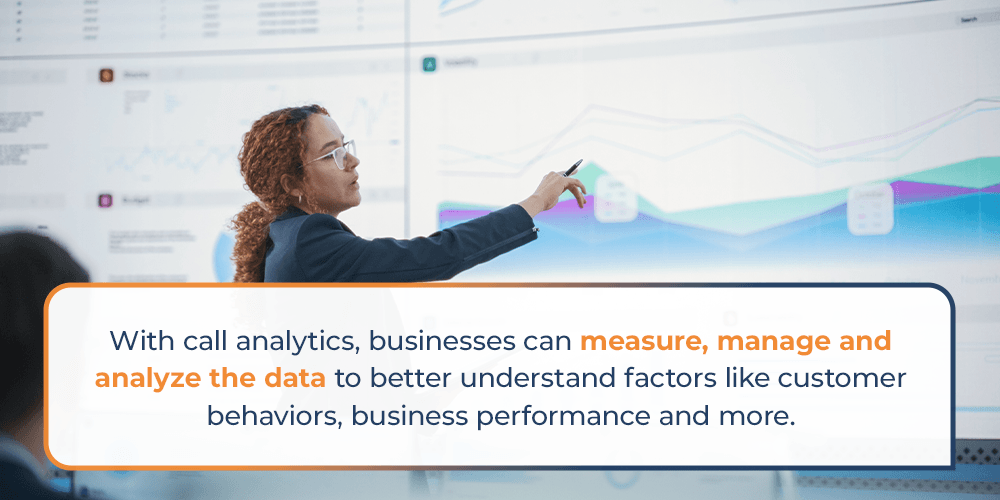Taking calls is an important aspect of many businesses, from law offices and medical facilities to real estate agents. Calls help you connect with leads and customers, and they also tell you about your company’s performance and customer satisfaction. With analytics, you can dive into these areas, improve your call methods and help your business grow.
Call analytics refers to data collected from phone calls. With call analytics, businesses can measure, manage and analyze the data they’ve collected to better understand factors like customer behaviors, business performance and more.
Analytics are collected through call tracking. With a call tracking solution, businesses can record conversations with basic call metrics and leverage AI to garner more information from the calls they track. This data can also be compiled into reports to showcase patterns in calls that can help businesses better understand their customer base.
The way a business uses call analytics can vary widely. Sales teams can use these analytics to monitor performance internally, while marketing departments might use them to learn more about audience segments.

Businesses can track various metrics through call tracking and analytics. Some of the most common metrics include:
These basic metrics can reveal a lot of information about your caller and your company’s performance over the phone. For example, if a larger number of calls go unanswered, you likely need additional support to handle calls.
Metrics can become more in-depth with the right technologies. For example, AI technologies can offer:
Call analytics offer several advantages.
Transcribing with call analytics creates an excellent training resource for sales teams. With a readable record of calls taken, trainers can review the best way to resolve customer problems and showcase what types of scenarios may come up over the phone.
Call recording and transcribing can also be helpful to monitor employee performance as they’re learning how to take calls. This capability reduces the need for trainers to shadow trainees and provides a resource for trainees to reflect on their experiences.
Call analytics can reveal weaknesses in your call strategy and help you identify how to improve your approach. For example, if your calls are frequently lasting for a long time, you might discover that callers are confused about a topic that requires further explanation.
Recognition of this pattern can help your team work out how to better talk about this confusing topic. Your team can develop stronger internal scripts and improve training as a result. Once you’ve implemented the performance improvement, you can save time on calls and improve the customer experience.

Call tracking helps businesses understand the various customer touchpoints over the phone and what additional marketing strategies can be used to customize the customer experience. This is particularly valuable for sales processes that require multiple calls with leads.
For example, call transcriptions might reveal that customers typically start asking questions about certain products on the second sales call. This information can inform your marketing team to send out an email about products that will likely interest a user based on their needs, answering their questions before they ask them.
Your collection of call analytics can help you make data-backed decisions. The choices you make will vary widely based on what your data reveals. A high number of unanswered calls often indicates you need more support for phone calls. You might also discover higher call volumes at certain points in the year, which might encourage you to outsource to a call answering service.
Another metric that may reveal a need for change is call time. If people often call your business after hours, this can indicate a need for 24/7 call answering.
Companies can use call analytics to understand what led a caller to contact them. This information can be collected with a quick survey after the first call, or it can be obtained through advanced analytics that track phone number link clicks from advertisements.
This data helps businesses improve return on investment (ROI) and cost efficiency by determining which marketing campaigns are most effective for their audiences. For instance, a business might discover that most calls originate from social media ads, so they can reduce spend on email campaigns as a result.
With more effective marketing campaigns, companies can invest in the methods that offer the most profitability for their business.
As call analytics technologies advance further, companies can find more ways to leverage their data and improve customer interactions over the phone. Some of the projected trends in call analytics include:
Implementing call analytics is a matter of using the right solution for your goals. Many software options can connect with your phone system to gather metrics while you take calls. If you’re looking for advanced AI analytics, these solutions can be helpful.
You can also look into a call answering service. Call answering providers help your business manage high call volumes when your internal team needs support. Plus, these services often include analytics to help your company better understand call patterns.
AnswerHero™ is a no-contract call answering service that operates 24/7/365. While you can enjoy support for after-hours calls and high call volumes, you can also communicate with more customers thanks to our bilingual agents. Contact us today or explore our pricing plans to get started.
